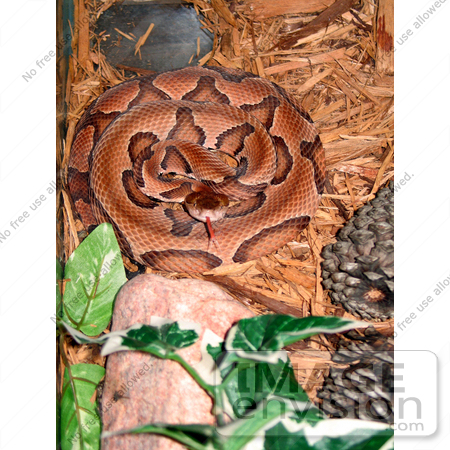

|
Picture of a venomous “southern” copperhead, A. contortrix contortrix, a denizen of the pine and deciduous forests of southeastern United States, and perhaps one of the best known, and widest ranging copperhead subspecies. It ranges throughout the Gulf Coast States, up the Mississippi River Valley to the level of southern Illinois and along the Atlantic Coastal Plain from extreme southern Delaware into the Florida panhandle (Gloyd and Conant, 1990), placing it in hurricane-prone areas, which is of importance to those living in these regions, and first-responders offering aid to those affected by such a disaster. Its Floridian range includes Gadsen, Liberty and Calhoun counties near the Apalachicola river basin (Tennant, 1998b). Reports of copperheads elsewhere in Florida are usually attributable to sightings of lightly pigmented cottonmouths or reddish colored non-venomous species such as corn snakes (Pantherophis gutatta) that are mistakenly identified. The dorsal body is patterned with 10 to 18 dark crossbands that are markedly constricted at the dorsal midline, 3 scales rows or less (Gloyd and Connant, 1990). Incomplete crossbands, the apices of which fail to meet at the dorsal midline, are common, most notably on the caudal half of the body (Gloyd and Connant 1990). The dark spots between crossbands in the dorsal pattern that are typical of the northern copperhead, are completely lacking on the dorsal body of “pure” members of A. contortrix contortrix. Unlike its broad banded and northern cousins, the crossbands of the southern copperhead do not extend down to the first scale rows of the lateral body (Gloyd and Connant, 1990). The ventrum is diffusely pale except for a series of round to ovoid dark ventrolateral spots corresponding to the areas between cross bands, and the lighter, slightly more ventral spots correspond with the central region of each dorsal crossband present on the lateral margins (Gloyd and Connant, 1990). This image was created in 2005 and provided by the Centers for Disease Control and Prevention/Edward J. Wozniak D.V.M., Ph.D. [0003-0702-0314-4043] by 0003
|
Keywords
a c contortrix, agkistrodon contortrix, animal, animals, cdc, chunk snake, copperhead, copperheads, reptile, reptiles, serpent, serpentes, snake, snakes, southern copperhead, southern copperheads, venomous snake
|
|








